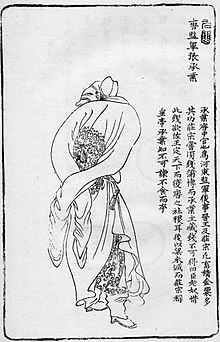
Back Wu Shuang Pu Afrikaans Ву Шуанг Пу Bulgarian وو شوانگ پو CKB Wu-šuang pchu Czech Wu Shuang Pu Danish Wu Shuang Pu German Γου Σουάνγκ Που Greek Wu Shuang Pu Spanish Wu Shuang Pu Basque وو شوانگ پو Persian
| Wu Shuang Pu | |||||||||||||||||||||||
|---|---|---|---|---|---|---|---|---|---|---|---|---|---|---|---|---|---|---|---|---|---|---|---|
 Zhang Chengye as depicted in the Wu Shuang Pu (無雙譜, Table of Peerless Heroes) by Jin Gulian | |||||||||||||||||||||||
| Traditional Chinese | 無雙譜 | ||||||||||||||||||||||
| Simplified Chinese | 无双谱 | ||||||||||||||||||||||
| |||||||||||||||||||||||
| Alternative name (Nanling Wu Shuang Pu) | |||||||||||||||||||||||
| Chinese | 南陵無雙譜 | ||||||||||||||||||||||
| Literal meaning | Nanling Table of Peerless Heroes | ||||||||||||||||||||||
| |||||||||||||||||||||||
Wu Shuang Pu | |
|---|---|
 Ban Chao (32–102) depicted on Chinese porcelain, Xianfeng period (1850–1861) |
Wu Shuang Pu | |
|---|---|
| Poem of Ban Zhao (45–116) | |
 She was the wife of Cao Shishu. She finished the book of the royal family that her father and brother has started. She served the royal family as a teacher. |
Wu Shuang Pu (Chinese: 無雙譜; lit. 'Table of Peerless Heroes') is a book of woodcut prints, first printed in 1694, early on in the Qing dynasty. This book contains the biographies and imagined portraits of 40 notable heroes and heroines from the Han dynasty to the Song dynasty, all accompanied by a brief introduction and guided by a related poem in yuefu style.[1][2] The illustrations from the book were widely distributed and re-used, often as motifs on Chinese porcelain.[3][4]
The original book has a seal that says Nanling, which is why the book is also known as Nanling Wu Shuang Pu. A re-edition of this book from the year 1699 is kept in the National Museum of China. In January 2006, an original hand-painted book of Wu Shuang Pu was sold at the Chongyuan auction house in Shanghai for 2.86 million CNY (US$440,000/£320,000).
The scholar and philologist Mao Qiling praised the book in the preface, he felt that the prose in this book formed a trinity with the poems and prints.
The painter of Wu Shuang Pu is Jin Shi (金史, c.1625–1695), who was known as Jin Guliang (金古良),[5][3] born in Shanyin (now Shaoxing, Zhejiang, China). Jin Guliang was inspired by Chen Hongshou and was following the examples of Cui Zizhong,[6] who initiated the first major revival of figure painting since the Song dynasty. Jin Guliang compiled the book together with woodcarver Zhu Gui.[4]
- ^ Lau, Josef S.M.; Goldblatt, Howard (2007). The Columbia Anthology of Modern Chinese Literature. Columbia University Press. pp. 616–626. ISBN 978-0231138406.
- ^ Wyatt, D. (2008). Wyatt, Don J (ed.). Battlefronts Real and Imagined, War, Border, and Identity in the Chinese Middle Period. Palgrave Macmillan US. pp. 31–32. doi:10.1057/9780230611719. ISBN 978-1-349-52631-4.
- ^ a b Wu, Yi-Li (2008-01-01). "The Gendered Medical Iconography of the Golden Mirror (Yuzuan yizong jinjian , 1742)". Asian Medicine. 4 (2): 452–491. doi:10.1163/157342009X12526658783736. ISSN 1573-420X.
- ^ a b Zhou, Yuhong (2013). "Appreciation and Analysis of Porcelain with 40 Figures of "Wushuang Pu" in the Late Qing Dynasty (Chinese language)". Baidu. "Translation into English".
- ^ "Wushuang Pu". St John's College, Cambridge. Retrieved June 7, 2021.
- ^ Santangelo, Paolo (2010). Materials for an Anatomy of Personality in Late Imperial China. Koninklijke Brill NV. p. 254. ISBN 978-90-474-3097-1.